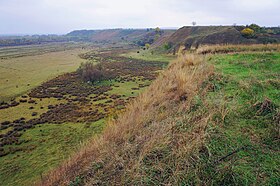You can help expand this article with text translated from the corresponding article in Serbian. (January 2011) Click [show] for important translation instructions.
|
Židovar is an archeological site[1] and settlement near Vršac, Serbia. This site is famous by the treasure that was found here.[2]

History
editThe earliest archeological findings date from the early Bronze Age and are followed by Middle Bronze Age relics of the Vatin culture and late Bronze Age remains of the Belegiš culture. The subsequent findings belonging to the early and middle Iron Age Bosut-Basarabi culture date back to the 9th to 8th century BC.[3] Finds of the La Tène era dating from the 2nd century BC until the 1st century AD, mostly pottery, accessories (jewelry, fibulae) and weapons, are mostly the work of the Scordisci. Their more numerous presence after the Celtic invasions in 279 BC, with a significant 10% belonging to the earlier Getae-Dacian cultures, is a result of co-existence and trading between the two peoples. The remains of the Scordisci fortifications with ditch and defense wall impart special importance to the site.[4][5]
In 1990, Židovar was added to the list of Archaeological Sites of Exceptional Importance under the protection of the Republic of Serbia.[6]
Gallery
edit-
View of Židovar
-
Aerial view of a Vatin culture tell at Židovar
See also
editReferences
edit- ^ Božič 1984, fig. 3
- ^ "Ostava sa blagom na skordiskom utvrđenju Židovar u severoistočnoj Srbiji". 30 May 2022.
- ^ "HISTORICAL PICTURE OF DEVELOPMENT OF EARLY IRON AGE IN THE SERBIAN DANUBE BASIN" (PDF). Retrieved 2023-08-22.
- ^ "Dacian settlements and necropolises in Southwestern Romania (2nd c. B.C.-1st c. A.D.)". Arheologie.ulbsibiu.ro. Retrieved 2022-08-02.
- ^ Popović 2000, p.83-111
- ^ Monuments of Culture in Serbia: "Жидовар" (SANU) (in Serbian and English)
44°56′59″N 21°15′47″E / 44.94972°N 21.26306°E